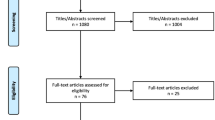Abstract
The associations between a number of reproductive and menopausal factors and bone mineral density (BMD) were studied in a sample of early postmenopausal women. The study included 580 women aged 45–61 years who completed a risk factor questionnaire containing sections on obstetric and menstrual history. BMD measurements were taken at the anteroposterior (AP) spine, greater trochanter, femoral neck, total radius and whole body, along with whole body bone mineral content (BMC). In analyses adjusting for key confounders, number of pregnancies was more strongly associated with increased BMD than number of live births at all sites (p<0.05 at femoral neck and total radius), and menstrual years was more strongly associated with increased BMD than years since menopause (p<0.05 at all sites). Hysterectomized women had a significantly higher adjusted mean BMD than non-hysterectomized women at all sites (AP spine: 0.999 g/cm2 vs 0.941 g/cm2, p<0.001), although there were no significant differences in BMD between hysterectomized women who had a bilateral oophorectomy and those whose ovaries were preserved. Negative associations between the duration of hot flushes and BMD were statistically significant (p<0.05) at the three non-hip sites. In multiple regression analyses containing all reproductive terms, duration of hormone replacement therapy (HRT) use, menstrual years and hysterectomy status were significantly associated with BMD at all five sites, whilst oral contraceptive use before the age of 23 years was significantly associated with increased BMD at all sites except the total radius. Breastfeeding duration, the duration of oral contraceptive use and premenopausal amenorrhea were found to have no association with BMD. Results for whole body BMC were consistent with those for the five BMD sites, across all the variables considered here. These findings confirm the importance of HRT use and duration of menses as predictors of BMD, whilst the results for hysterectomy status and early oral contraceptive use require further consideration.
Similar content being viewed by others
Author information
Authors and Affiliations
Additional information
Received: 26 July 2000 / Accepted: 5 April 2001
Rights and permissions
About this article
Cite this article
Grainge, M., Coupland, C., Cliffe, S. et al. Reproductive, Menstrual and Menopausal Factors: Which Are Associated with Bone Mineral Density in Early Postmenopausal Women? . Osteoporos Int 12, 777–787 (2001). https://doi.org/10.1007/s001980170055
Published:
Issue Date:
DOI: https://doi.org/10.1007/s001980170055




